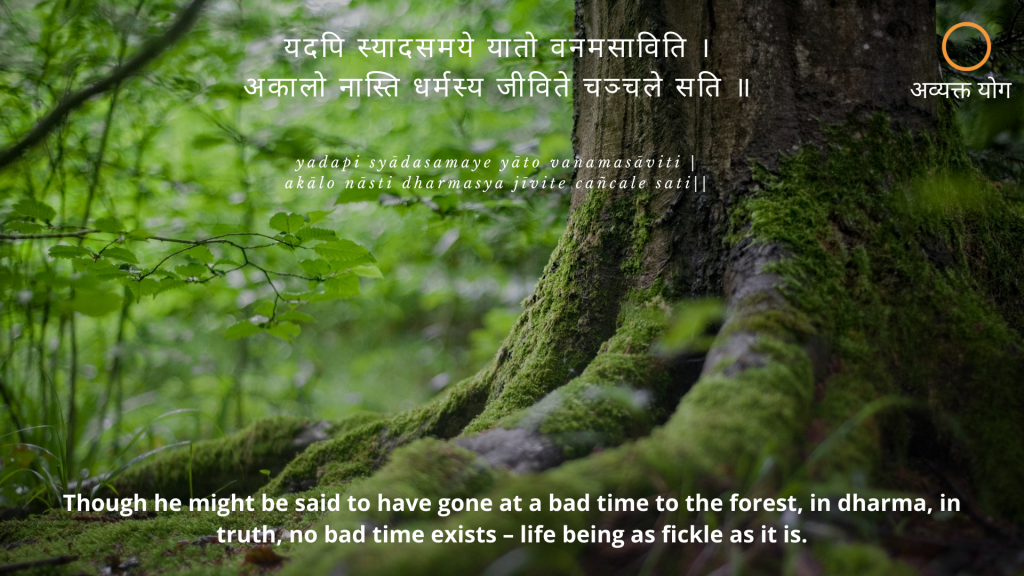यदपि स्यादसमये यातो वनमसाविति ।
अकालो नास्ति धर्मस्य जीविते चञ्चले सति ॥
yadapi syādasamaye yāto vanamasāviti |
akālo nāsti dharmasya jīvite cañcale sati||
Buddhacarita 6.21, by Aśvaghoṣa
Though he might be said to have gone at a bad time to the forest, in dharma, in truth, no bad time exists – life being as fickle as it is.

The Buddhacarita (Saddharma-pundarika) by Aśvaghoṣa is a famous Sanskrit mahākāvya revolving around the live and exploits of the Buddha. In those days, the āśrama system of living was practiced, where the human lifespan was divided into 4 stages, each approximately 25 years (āśramas). Each āśrama focused on the development of some specific facets of the individual, and aiding fulfilment of his or her duties – Brahmacarya (learning), gṛhastha (household), vānaprastha (retirement) and sannyāsa (renunciation). Of these, the sannyāsa stage was mostly carried out in a forest, away from humanity. The vānaprastha stage was for preparation of going to the forest.
On the surface, this śloka speaks about living life as per dharmā, or the right path, and that there is no good time to begin living this way, given the fragility of life. The latter half of this sentence holds special importance. Two months back, who could have thought that life would come to a near standstill, the whole world would be locked down, and we would be taking permissions to even step out of our homes? Who would have thought that going to the supermarket would be a task in itself, and that birthdays and anniversaries would be muted celebrations within our houses? Or that oil would trade below one dollar a barrel? Or that more than 180,000 people would be dead from a virus, with more than 40,000 dead in the most advanced country in the world?
Yes, life is fickle, and there is no better time than now to actually realise it.
According to research done by Dr. Daniel Gilbert of Harvard University, people are really bad at predicting who they will be in the future (your future self). The reason is simple: it’s far easier to remember the past than to imagine the future.
According to Chris Bailey,
the more you see your “future self”as a stranger, the more likely you are to give your future self the same workload that you would give a stranger, and put things off to tomorrow.
It’s important to get in touch with your future self, by doing things like sending a letter to future you, creating a “future memory,” or even downloading an app that will show you what you look like in the future.
And so, with this realisation, we need to re-evaluate our lives, our priorities and ways of living.
There is no better time, than NOW. If you want to change your life, there is no better time than NOW.
If you wanted to start to learn something, or to drop a habit, or to exercise, or to say I love you – there is no better time than NOW. Be kinder to your future self, realise that whatever you put off today – a healthier lifestyle, a sustained savings plan, a better way of living and thinking – will all affect YOU in the future.
And as the next śloka aptly puts it:
तस्मादद्यैव मे श्रेयश्चेतव्यमिति निश्चयः ।
जीविते को हि विश्रम्भो मृत्यौ प्रत्यर्थिनि स्थिते ||
tasmādadyaiva me śreyaścetavyamiti niścayaḥ |
jīvite ko hi viśrambho mṛtyau pratyarthini sthite ||
Buddhacarita 6.21, by Aśvaghoṣa
Therefore my determination is, ‘I must seek my supreme good this very day.’ For who can rely on lasting life while death stands by?
My feathered friends, they do not plan for the future. They may not even know of a future. Whatever they do, they do today. Sing a beautiful song, fly to a new tree branch, and enjoy it swaying in the wind – yes, here is them living in the moment…
